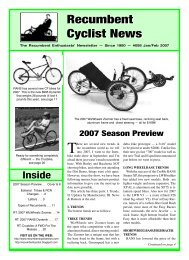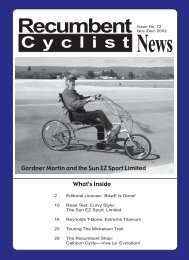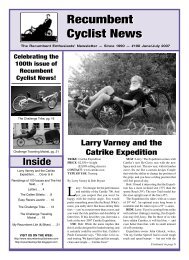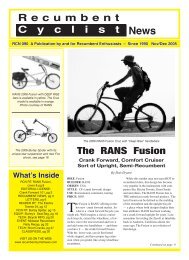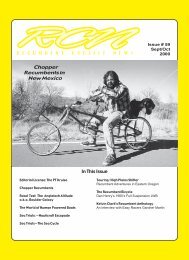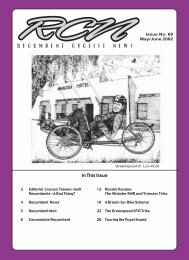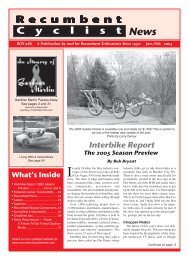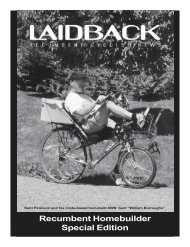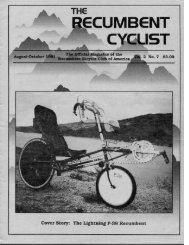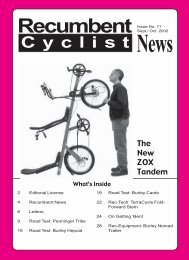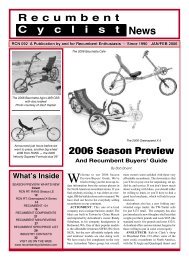C y c l i s t Recumbent - Steve Briggs
C y c l i s t Recumbent - Steve Briggs
C y c l i s t Recumbent - Steve Briggs
- No tags were found...
Create successful ePaper yourself
Turn your PDF publications into a flip-book with our unique Google optimized e-Paper software.
<strong>Recumbent</strong> SafetyBy Bob BryantBicycle safety is a subject that is just notwritten about enough. This article iswritten primarily for those recumbentriders who plan to use their bikes for transportation.But even if you ride recreationally on abike trail, you will also glean some useful informationfrom this article.Back in 1975, John Forester wrote the firstedition of the classic bicycling book, EffectiveCycling. In this book he outlined what hecalled “vehicular cycling principles.”Forester’s principles can be summed up in thisone sentence: “Cyclists fare best when theyact and are treated as drivers of vehicles.” Asstated in The Art of Urban Cycling by RobertHurst, Forester’s principles “won over the cyclingcommunity.” They are still taught to thisday by the League of American Bicyclists.In The Art of Urban Cycling, Hurst notesthat there are 65 million more people and evenmore cars than there were back in the 1970s.He advocates that modern urban cyclists needto be a bit more flexible as to routes and safety.After a series of close calls this past spring,I started researching the cycling safety booksjust to make sure that I was doing the rightthing. I’ve always blazed my own trail whenriding. I don’t need to be out with the cars onthe road. If there is a bike or multi-use trailgoing in my direction, I’m there. I chooselightly-traveled roads, and I carefully considerthe various situations that I get into.I had several spots on my commute where Iwas having repeated problems with cars:In downtown Port Townsend there is a ferrydock. In the summer, there is always a line ofcars. I stay in the bike lane, which then becomesthe ferry turn lane and then ends at theferry dock. I move from the bike lane/ferry turnlane into the main lane of traffic. I ride 40%out into the lane so that cars cannot pass me.The reason why I do this is that there is a stripmall less than one block after the ferry dock.Several times a month cars would pass me, andimmediately cut me off by turning right acrossmy path into the mall. I confronted a few ofthese drivers. Two actually said the same thingto me: “You were in my road,” and “What amI supposed to do?” I reminded them that I hada full legal right to that lane. But now I don’tgive them the chance; I ride out in the lane.Further into town traffic slows down to a20 mph two-lane main street. Many safety advocateswould tell me to stay out of the bikelane for fear of being hit by an opening cardoor; and to ride in traffic if I’m going the samespeed as the traffic. While in principle thissounds right, often the traffic is going less than10 mph or is stop-and-go. If I sit there withthe cars, I end up overdosing on exhaust fumes.In this case, I carefully ride up the bike lane— carefully not getting too close to the parkedcars or to the line of stopped traffic. To makematters even more like a video game, there areoften delivery trucks parked down the centerof the street so a careful cyclists needs to beaware of the “squeeze”.On a rural street out towards my house thetwo lanes haven’t been resurfaced in years andare full of potholes and ruts. If I ride in theright 20-30% of the lane, drivers quite oftenwill attempt to pass. The lane narrows significantlyand I’ve been run off the road severaltimes (most recently by a bus). In this situation,I have now moved out into the lane sothat the cars cannot pass, or they have to moveinto the oncoming lane to pass. Ridiculously,many try to pass anyway when they don’t needto. I’ve measured my speed at over 20 mphthrough this area, and the speed limit is only25 mph.I’ve never admitted publicly to my flexibleview of Forester’s “effective cycling” concepts.It wasn’t until I read The Art of UrbanCycling that I became empowered and beganto see myself as a capable, experienced cyclistwho is able to ride in a safe and predictableway — even though it doesn’t go along 100%with the rules of “effective cycling.” My recommendationto RCN readers is to visit someof the websites outlined below and perhapscheck out some books from your local library.Think about the situations on your rides/commutesand come up with careful and safe waysto handle them. Also, riding a bike suited fortraffic riding and having adequate safety gearwill help you along the way.Safety EquipmentAs a commuter cyclist, I ride 10-12 miles,twice per day, to the post office and back andon errands around town (combined with fitnessrides). After several close calls this lastseason, I decided that I had to make somechanges to be seen by motorists. The informationbelow outlines some of the changes that Imade to get safe.Bell: I have a thumb activated bell to alertother riders, pedestrians, and dogs of my presence.Something like the Incredibell sells for$6-$11.Horn: In traffic you need more than a bell.The Airzound air horn ($30) is a good way togo when you need to get the attention of cardrivers. Yelling at the top of your lungs is anotherway to alert them.Flag (vertical): Most recumbent trikes comewith safety flags. For those that don’t, mostbike shops sell safety flags. If anybody knowsof a good source for a two-piece flag pole andhigh-quality flag, please let us know.Flag (horizontal): The Flash Flag will helpmotorists judge just how much room to leaveyou in traffic. www.flashback.ca. Some feelthis is a great idea, others have told me that itmay antagonize motorists. I haven’t tried it yet,but would do so on a two-wheel commuterbike.Helmet: This is a must-have, and don’t useyour 25-year old Bell helmet or your kid’sroller blade helmet. Get a modern helmet thatfits you well. For urban cyclists, the Bell Metrois the helmet that people are talking about.Lights: On dark or drizzly days, or in falland winter, I ride with the lights on. RCN lightexpert Kent Peterson tells me that the best andmost affordable basic lights available out thereare the 1000 candle power Cateye EL500 LEDheadlight ($50) and the LD1000 tail light. TheLD-1000 has 10-LED lights that flash on thesides and to the rear (about $35). Both run onAA batteries. Another option is a clear flasheron your handlebars.One of my bikes has a hub dynamo generatorand light combo. I loved this until I realizedthat a friend’s Cateye light was brighterand doesn’t flicker with varying power output.Mirror (rear view): I ride so many differentbikes that I like a mirror that attaches tomy glasses. I use a Take-A-Look (see RCN085, pg. 8). I’ve had this mirror for years. Ifind that glasses or helmet mirrors vibrate less,but consult your selling dealer to find a mirrorthat works best for you. Just get a mirror —this is the single most important safety optionyou can get for a recumbent bicycle.The Mountain Mirrycle mirror is a highqualityand widely-used handlebar mount mirror($15).Reflective products: I wear a fluorescentgreen cycling jacket. Mine is made by PearlIzumi. I also have a Burley rain coat that isbright yellow with some reflective materialsewn in. It is a wise decision to place reflectivesafety triangles on the back of your bike.Safe <strong>Recumbent</strong>sCompact Long Wheelbase (CLWB): Theseare the ultimate commuter/recreational design.A suspended model, like the HP Velo Spirit,can be a very comfy urban ride. They tend tobe heavier, and not perform as well once youget out on the open road. The tall and uprightposition gives a safe and commanding viewof the urban environment.Long Wheelbase (LWB): While these bikesare long, they are lower than a SWB or CLWB.The length can be an issue for some, but mostare user-friendly enough. Fairings can maketight turns an issue. LWBs are generally20 <strong>Recumbent</strong> Cyclist News



